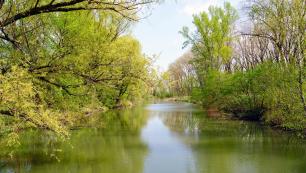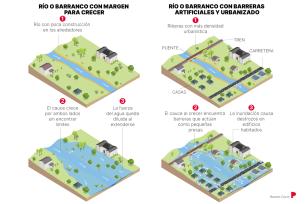
When people talk about cleaning the riverbeds they are referring to extracting their vegetation and this is a serious hydrological and ecological mistake.
Faced with the serious consequences of the DANA in Valencia, many people have begun to wonder what to do to prevent the devastating impacts of floods -even more so if we consider that their frequency is increasing. Unfortunately, among the proposals to improve prevention, some misinformation has been circulating that advises more channeling of rivers and removal of vegetation from riverbeds to prevent floods. This statement is false and we have talked about it with our research technician Pau Fortuño to clarify it, since he has focused his thesis on the study of Mediterranean rivers.
“When people talk about cleaning riverbeds they refer to extracting their vegetation and this is a serious hydrological and ecological error. The vegetation that surrounds the rivers is adapted to the river floods, because it is flexible and robust at the same time, and it acts as a brake when there are floods. It is part of its natural function. On the other hand, if we remove this vegetation and begin to channel the rivers, the water picks up more and more speed as it descends from the headwaters or the area of the storm because it does not find any friction to slow it down and, when it finds a curve to exit, the effects are worse,” explains Fortuño. Precisely, many times the great evils of a flood are not caused by the flood itself but because the water takes these great sweeping speeds.
How, then, do we protect cities from floods with a forward-looking strategy? According to the expert, “there is no zero risk, but to reduce the consequences of floods it is necessary that the riverbeds are not occupied by houses, industrial or commercial buildings, roads, railroad tracks or retaining walls and that they have margins wide enough to grow and shrink without endangering the population. In addition, these banks must not lack native vegetation, the classic riparian forest, because it is the one that will help us to control the speed of the river in a stable way over the years. It is an urgent restoration of nature“.

River with riparian forest. Public domain image.
Diverting the problem
In the same line of misinformation, some people defended in social networks that the canalization of the Turia in the year 69 -during the Franco regime- has saved Valencia from an even worse tragedy. The reality, however, is that “the canalization of the Turia has helped Valencia city not to have serious problems, but, in part, it has also diverted the problem to the south of the city, precisely in the area of Ribera Baixa, which has been the most affected and where other streams and ravines that carried huge volumes of water also ended up. And those volumes could not have been contained anywhere by canals or retaining walls, so they are not the key to long-term prevention. And even less so now that they should be rebuilt every 50 or 80 years if we consider that there will be increasingly more virulent climatic phenomena due to climate change,” says Fortuño.
In the Valencian case, “the sum of narrow streams, built in the surroundings, channeled, with transverse communication routes and without vegetation has been one of the reasons for such a powerful impact”. But it is not the only case, since in Catalonia there are also many flood zones with these mechanisms, as for example in the Llobregat river or the Garona, which already caused damage in Vielha in 2013. Moreover: there are already cases of proven success of how the removal of channels and the return of the river to its natural channel are preventing flooding, as in the case of the final stretch of the Arga River in Navarra.

The canalization of rivers and the (misnamed) cleaning of riverbeds increase the speed of the water and, therefore, its destructive force. Illustration: Ramon Curto, El Periódico.
Reed and riparian forest
To clarify a key concept, when we talk about vegetation around rivers, we are not talking about reeds. The common reed (Arundo donax) is an exotic and invasive species and in no case is it protected -another fake new these days-. In fact, there are aids and eradication plans for its frequent control and elimination from the river banks. “The problem is that the reed has a brutal colonization power, with very high mass volumes, and as in many areas we do not have healthy riparian forests, it has no natural control. If the riverbeds had the trees that correspond to them, such as elms or poplars, the reed would not have all the light it needs to grow. Instead, with this erroneous idea of leaving the riverbeds bare, we encourage the reed to grow more and more,” says Pau Fortuño.
Thus, when we speak of a riparian forest we are talking about the native vegetation that grows and matures around rivers and which in the Mediterranean corresponds to species such as poplar, tamarack, alder, narrow-leaved and broad-leaved ash, hazel, elder... typical of wetlands .

